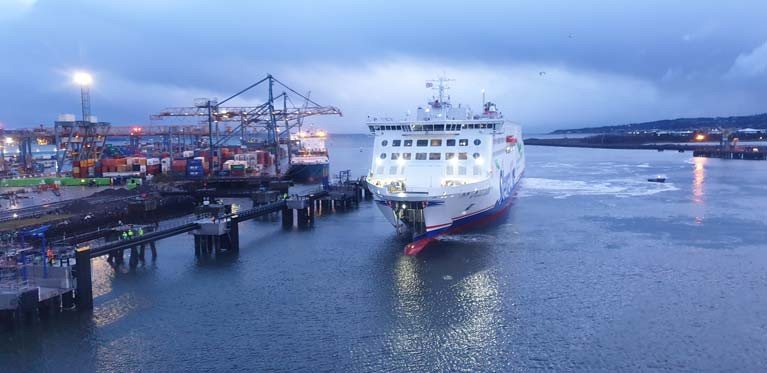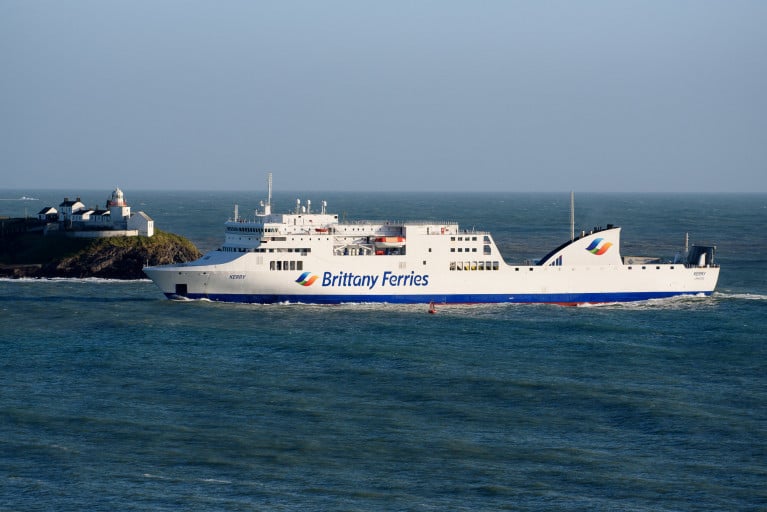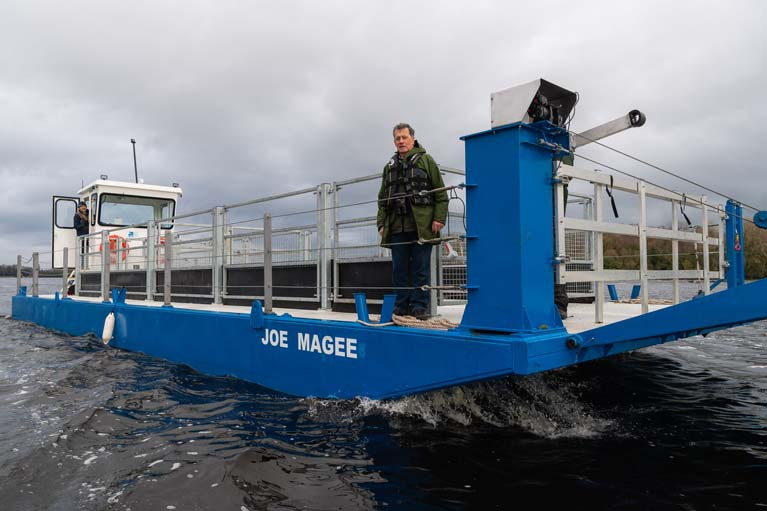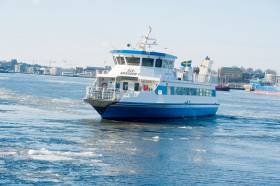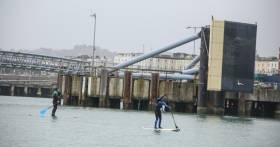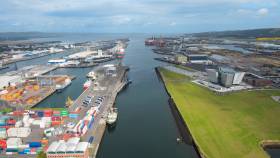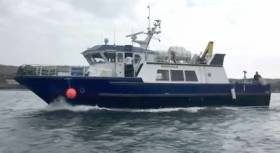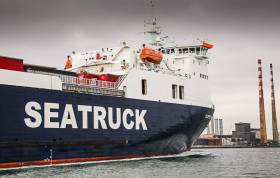Displaying items by tag: ferry
New Stena Line Ferry Arrives in Northern Ireland for Final Trials
The next generation of ferry travel proudly sailed into Belfast Harbour on Wednesday, with Stena Edda undertaking important final trials before it welcomes passengers on the Belfast Lough to Liverpool route in the coming weeks.
As Afloat reported earlier, the Stena Edda arrived at dawn after an epic four-week voyage and over six years’ in planning and construction, including design development in Sweden.
As part of this momentous occasion on its journey, the new advanced vessel took part in successful berthing trials at Belfast Harbour’s VT2 Terminal. A new access ramp has been specially built to accommodate the multi-million-pound ferry in Belfast.
With 40% more deck capacity, 40% more cabins and 30% more fuel-efficient than current vessels on the route, it will accommodate up to 1,000 passengers, 120 cars in its dedicated garage deck and 3,100 lane metres of freight.
It is more spacious inside with a Sky Bar and Scandinavian design providing new levels of comfort for both freight and travel guests. Despite the 215 metres length of the ferry, the new port infrastructure will deliver easier and faster loading and unloading for all passengers.
Stena Edda is part of a nine-figure investment by Stena Line in three new vessels and port upgrades, redefining ferry travel in the Irish Sea. Stena Edda is the first of two new ferries that will run on the popular Belfast to Liverpool route.
Port of Cork Responds to Brittany Ferries Decision To Finish the Cork to Santander Ferry Route
The Port of Cork have been informed by Brittany Ferries that the weekly Ro-Pax ferry service from Cork to Santander which includes a midweek Roscoff sailing is to cease operating. In a statement, the Port said: 'This surprising decision by Brittany Ferries is very disappointing, however, we will continue to pursue other options for linking Cork and Northern Spain".
As Afloat reported yesterday, Brittany Ferries is believed to be looking at moving the operation to Rosslare Harbour.
A Port spokesman added: "We remain supportive of Brittany Ferries who have operated out of Cork for over 40 years and we will continue to facilitate Brittany Ferries on their weekly service from Cork to Roscoff re-commencing in March 2020"
The traditional Lough Erne Cot is a vessel unique to Upper and Lower Lough Erne and used there for possibly 2000 years. It was popular for transporting goods, people and cattle around the islands in the lakes in County Fermanagh and some versions are still used today for carrying cattle.
The cot was uniquely suitable for this purpose, being flat bottomed, wide in the middle and narrow in its turned-up ends. Some were surprisingly long at 15 to 18 metres. But the latest design of the ‘cot’ commissioned by the RSPB, is a far cry from the original. It’s a 15m custom-made 14-ton vessel built by Welsh marine engineers and workboat builders Mainstay Marine Solutions.
As Afloat previously reported, not only will it transport livestock but also machinery, equipment and people and its deck space can be altered depending on the cargo. It can also be dismantled into sections for ease of road transportation.
The grazing of cattle on the islands helps ground-nesting birds by providing cover. The livestock creates a suitable structure of grass and vegetation to form an ideal habitat for breeding wading birds including curlews, lapwings, redshanks and snipe to nest and raise young.
The boat has been named the ‘Joe Magee’ after a former RSPB Fermanagh warden who had noticed the alarming decline in wading birds during his time there. The new cot was acquired through the Co-operation Across Borders for Biodiversity (CABB) project, which receives financial support from the EU’s INTERREG VA Programme, managed by the Special EU Programmes Body (SEUPB). CABB is improving the habitat for breeding wading birds at several sites in Northern Ireland and the Republic of Ireland and blanket bog habitat in NI, Scotland and the Republic of Ireland.
RSPB NI has operated a cot to transport livestock between islands on Lower Lough Erne since 1991. The original was designed by Joe Magee but needed to be replaced due to wear and tear.
RSPB NI area manager Brad Robson explained: “The cot is used throughout the year. We move about 150 cattle and 60 sheep back and forth to our managed islands, as well as livestock to other privately owned islands. In its first voyages, the new vessel will be used to bring livestock off for the winter”.
Joe Magee added: “We originally used a wooden cot, which a farmer let us use, and then we built our own. “Although at first it had no engine on it, and we had to tow it using another boat. So eventually we got an engine and that made life easier. “I knew that across the island of
Ireland curlew numbers were dropping, so it’s important that work is still being done to look after them.”
Mr Robson said the RSPB's work is essential and by using cattle to manage the grassland they can give curlews "the best possible opportunity that they can rear young successfully”.
Underlining the importance of this part of the project, Gina McIntyre - CEO of the SEUPB - said: “The curlew is one of a number of endangered priority species identified in the environmental protection measures within the EU INTERREG Programme. This new cot is a fantastic example of the tangible impact that EU INTERREG funding is having in safeguarding the natural environment and protecting endangered species, on a cross-border basis. Due to this intervention by the CABB project, curlews will have a much better future. I also want to commend Joe for his commitment to conservation.”
You can read more here
New Spike Island Ferry Operating in Cork Harbour
A new Cork Harbour ferry has been launched to Spike Island to coincide with the opening of a major new exhibition there, and it's hoped these initiatives will lead to a rise in tourist visitor numbers writes Bob Bateman.
The ferry, named after the island, can accommodate 126 passengers and will be operated by Doyle Shipping.
As Afloat previously reported, the number of visitors to Spike Island has risen to 25% so far in 2019, with the operation of a new, larger-capacity ferry just one of a number of developments at the Cork Harbour destination.
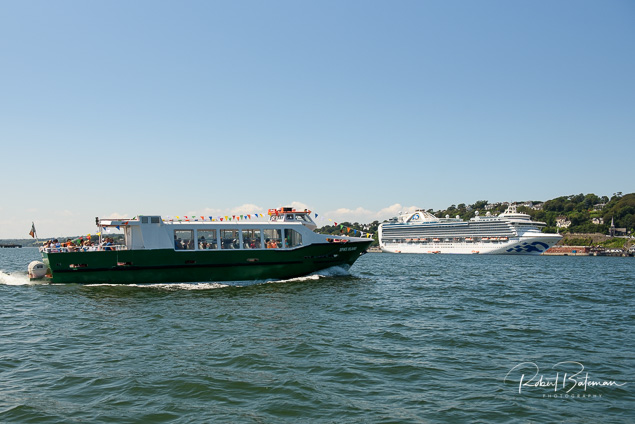 The Ferry crossing Cork Harbour Photo: Bob Bateman
The Ferry crossing Cork Harbour Photo: Bob Bateman
The new ferry will run alongside the existing ferry, ‘Bryan J’, which carries 80 passengers, and thus increase the throughput of tourists to the 104-acre island.
Doyle Shipping has carried passengers to the island for the past 60 years. They have included army and navy officers, sitting Taoiseach, and famous criminals like Martin Cahill.
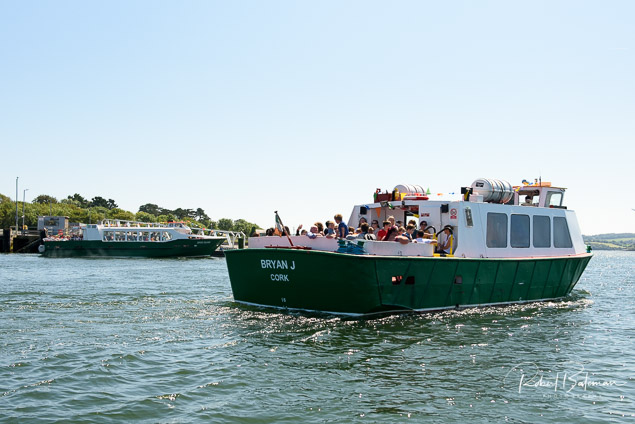 The busy Bryan J Ferry also operates to Spike Island Photo: Bob Bateman
The busy Bryan J Ferry also operates to Spike Island Photo: Bob Bateman
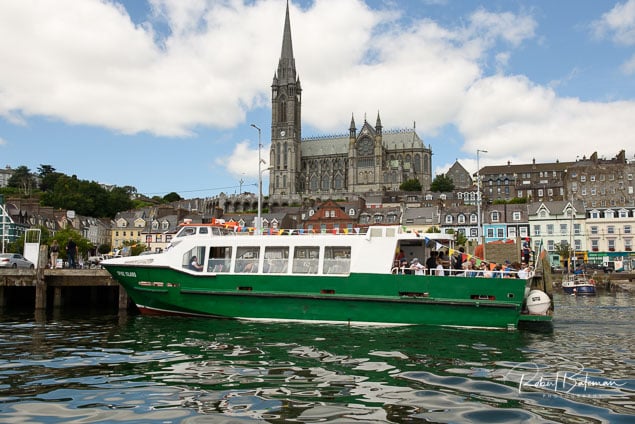 Embarkation at Cobh Photo: Bob Bateman
Embarkation at Cobh Photo: Bob Bateman
Electric Ferry Takes to the Water with Volvo Penta in Sweden
In the next phase of Gothenburg’s drive to connect its residents with a seamless citywide low emission commuting network, a Volvo Penta-powered electric ferry service is being introduced into the ElectriCity transport ecosystem.
Building on the growing success of Gothenburg’s ElectriCity project, an all-electric ferry service is to be added to the City’s existing electric bus service. The electric marine propulsion system is being provided by Volvo Penta, who joins the initiative following the success of sister company’s Volvo Buses – a leading partner in the ElectriCity project – having supplied the buses to the Route 55 electric bus route in Central Gothenburg and the electric articulated buses on Route 16. Aimed to be the model of future clean urban development, the new electric-powered ferry will link both sides of the Göta River.
Gothenburg’s ElectriCity partnership is a collaboration between industry, academia and local government. It involves developing, testing, demonstrating and evaluating solutions that will contribute to the establishment of new, sustainable, attractive transportation systems and open up new opportunities for future travel, transportation of goods and urban planning. Using electric power in public transport systems helps to resolve problems such as noise and poor air quality, as well as lowering energy use and the impact of transport on the climate.
Powering up electric waterways
While Gothenburg’s waterways already feature ferries powered by electricity, in the form of diesel-electric engines, these operate on short routes across the river. ElectriCity’s Volvo Penta-powered electric vessel, meanwhile, will be the first fully-electric ferry in the city able to complete longer, multi-stop routes along the river, and ultimately incorporate quick charging capabilities.
The opening of the route is part of a longer-term plan to introduce more clean energy ferry solutions and the development of a marine demo arena. Cities around the world are often built around waterways and connecting on-road with on-water sustainable transport in a unified traffic system is a final objective.
The ferry – Älvsnabben 4 – will be converted into the all-electric drive at the hands of Volvo Penta, in collaboration with Västtrafik’s operator, Styrsöbolaget, part of Transdev. The work involves removing diesel engine-powered marine drivelines and replacing them with a battery-electric propulsion system of equal power to the outgoing diesel powerplant, but one that boasts considerably more maximum torque. Initially, the ferry will be charged overnight, supported by an onboard genset running on HVO.
The current plan is for the refit to get underway early next year, with the target of the ferry entering commercial service on the Göta river by the end of 2020.
“We fully support ElectriCity’s ambition to bring Gothenburg to life by connecting people across the city in a sustainable way,” explains Björn Ingemanson, President of Volvo Penta. “Volvo Penta has an advantage when it comes to electromobility. As part of the Volvo Group, we have access to the technology and expertise from many years of development with electric buses in the city of Gothenburg, where aspects like safety and efficiency have been at the forefront. Now, we aim to adapt this leading technology for use in a marine environment, bringing the benefits of proven technology into a new context.”
Clean. Efficient. Connected. City
Gothenburg is one of the world’s most progressive cities when it comes to addressing climate and environmental issues. The city currently has the highest ranking in the 2019 Global Destination Sustainability index. Ongoing initiatives such as the Volvo Penta-powered electric ferry service will, over time, form an integrated part of Gothenburg’s long-term clean energy transport infrastructure.
“Västtrafik is aiming to reduce CO2 emissions by 90 percent before 2035. To reach this goal large-scale electrification of all our city services is crucial. This ElectriCity initiative is an important step in the right direction, and we are looking forward to adding the Volvo Penta fully electric ferry to our transport system”, says Camilla Holtet, director of development at Västtrafik.
Speculation That a Ferry Could Return to Dun Laoghaire Harbour
Is a new ferry route coming to Dun Laoghaire Harbour? After an absence of three years or more there is more than the usual level of a rumour circulating at the south Dublin Port that a regular passenger service could be coming back after the recent break in what – until 2015 – was a continuous 200–year service from Dun Laoghaire.
Insiders say that they are 'very confident' a ferry service can be reintroduced but for now, the new harbour owners, Dun Laoghaire Rathdown County Council, are tight-lipped in a statement to Afloat.ie about any plans concerning a ferry or its proposed routing.
As regular Afloat.ie readers will know, Dun Laoghaire Harbour Company was dissolved on the 3rd October 2018 and transferred to Dún Laoghaire-Rathdown County Council under the Harbour Act, 2015.
An Afloat.ie source told Afloat.ie last week a new ferry deal is 'in discussion' but, unfortunately, no other details are forthcoming.
A shipping industry told Afloat.ie the only viable ferry berth now available in the harbour would be Berth Number Four that has a linkspan to accommodate small ships. This is the berth adjacent to St. Michael's Wharf, at the old ferry terminal, next door to the Royal St. George Yacht Club.
The 200-year-old Harbour and its tenants are now in a period of transition and have to address a number of issues not least the state of repair of the harbour and also the financial standing of the Company. Final accounts must be presented to the Minister for Housing, Planning and Local Government and laid before the Oireachtas. This must be completed within six months from the 3rd October 2018.
The Council met last week with harbour tenants and explained to them that it is applying for European Regional Development Fund (ERDF). The hope is that the Council, the second biggest in the country, can bring some financial muscle to bear to restore the Victorian structure that suffered so badly in storms last March.
Stakeholder engagement between Dún Laoghaire #harbour users and the #dlrcc council this morning. Really useful for everyone. Great opportunity for everyone to connect. pic.twitter.com/61bvjisP7J
— dlrcc (@dlrcc) November 16, 2018
In a statement, Dún Laoghaire-Rathdown County Council told Afloat.ie that 'All proposed projects, including any potential ferry service, are being reviewed against this background'.
Evacuation from Ferry Amid Fears of ‘Device’ On Board
#BelfastLough - An evacuation of passengers according to ITV News from a ferry took place after a report that a “device” had been left on board.
The Police Service of Northern Ireland said the Belfast to Liverpool service was held in the Northern Irish capital while the vessel was searched.
At around 12.50am on Sunday, the PSNI said no device was found and passengers were allowed to re-embark.
For more including a statement tweeted by the police click here.
Order Signed for Two Additional Stena E-Flexer Ferries
#FerryNews - An option to build a seventh and eighth of the E-Flexer ro ro class has been decided by Stena.
The two vessels will be deployed within the ferry company's route network with a planned delivery in 2022. Additionally, Stena RoRo has taken an option on the construction of a further four E-Flexer vessels also to be built at Avic Weihai Shipyard, China.
“We are very pleased to have ordered two additional E-Flexer vessels from Stena RoRo. We foresee increasing demand for freight capacity in Northern Europe and our new vessels fit very well in matching anticipated market developments as we prepare ourselves for further expansion. At this stage we haven’t decided where within our route network these two vessels will be deployed and are currently evaluating several options,”says Niclas Mårtensson, CEO Stena Line.
The new order and the four further options are important milestones for Stena RoRo.
“These vessels are the result of good cooperation between Stena RoRo and the AVIC Weihai Shipyard. With their strong design capabilities, Stena Line will be able to optimise its capacity to accommodate the vessels within most parts of its route network,” says Per Westling, MD Stena RoRo.
As with the previous E-Flexer vessels ordered by Stena, energy efficiency and sustainability will be key design features.
“We want to lead the development of sustainable shipping and set new industry standards when it comes to operational performance, emissions and cost competiveness,” says Niclas Mårtensson.
The two new ships on order will be larger than the three E-Flexer designs currently being built for Stena Line. The first three E-Flexer ships will be 215 meters long with 3 100 (lm) lane meters whilst the next two ships will measure 240 meters with a freight capacity of 3 600 lane meters.
“We are building on our successful RoPax concept mixing freight and passenger traffic. Through standardisation we can secure a reliable operation and by investing in tonnage that is flexible we can provide an even better product that will ultimately support our customers and help them to grow,” said Niclas Mårtensson.
A total of eight E-Flexers have now been ordered by Stena from Avic Weihai Shipyard in China. The first one is planned to operate on Holyhead-Dublin (in early 2020) and the next two delivered are planned to operate on the Liverpool-Belfast service. Three other vessels will be chartered out to external ferry operators by Stena RoRo.
Facts about E-Flexer 7 and 8
Length over all (LOA): 239,7 m
Width: 27,8 m
Draught, max: 6,4 m
Pax capacity: 1200
No of cabins: 263
Capacity: 3 600 lm
Cape Clear Island Has a New Fast Ferry
Cape Clear Island has a new fast ferry. The MV Bremenholm has been brought from Norway by the Cape Clear Ferry Company.
Announcing its arrival the company said that it is capable of up to 20–knots speed and is intended initially for the Schull to Cape route in West Cork.
“Permission will be sought from the Department of Culture, Heritage and the Gaeltacht to use it on the Baltimore-Cape Clear Island route as well,” the company said in a statement. It has a crane and cargo capacity of 6 tons, with high quality passenger accommodation, airline style seating, large saloon windows, air conditioning, saloon and other features.
“Our company is committed to on-going improvements in all aspects of the Cape Clear Island Ferry Service. We hope that this vessel will prove the concept of a fast ferry service for the future. There are a number of steps needed to re-register this vessel with the Irish Marine Survey Office following which more details will become available regarding passenger numbers and other matters. This investment represents a very significant upgrading of the ferry services in West Cork.”
Dublin Port Trade Volumes up 4.2% in First Nine Months of 2017
Dublin Port Company has published its latest trade figures showing growth of 4.2% to the end of Q3 2017. Overall, volumes in Dublin Port have grown by 30.1% in just five years.
A continuation in the current pace of growth would mean a third successive record year for Dublin Port.
Summary of YTD September 2017 Trade Statistics
|
Gross tonnes |
Q3 2017 |
Q3 2016 |
% change |
|
Imports |
16.0m |
15.4m |
3.5% |
|
Exports |
11.2m |
10.6m |
5.2% |
|
Total Throughput |
27.1m |
26.0m |
4.2% |
|
Ro-Ro units |
736,462 |
699,361 |
5.3% |
|
Lo-Lo TEU |
515,718 |
495,511 |
4.1% |
|
Ferry passengers |
1,496,025 |
1,460,585 |
2.4% |
|
Tourist vehicles |
411,921 |
400,949 |
2.7% |
|
Cruise ships |
127 |
103 |
23.3% |
|
Trade vehicles |
73,252 |
77,494 |
-5.5% |
Total throughput (imports and exports) for the nine months to the end of September was 27.1 million gross tonnes, with 5,932 ship arrivals during the period.
Consecutive Growth over the past five years
This is the fifth year in a row for Dublin Port to see substantial growth in the first nine months.
|
Trade Period |
% growth |
|
Q3 2013 |
3.1% |
|
Q3 2014 |
7.2% |
|
Q3 2015 |
5.8% |
|
Q3 2016 |
6.8% |
|
Q3 2017 |
4.2% |
New Ro-Ro Service
Growth was particularly strong in Ro-Ro freight with 736,462 units in the first nine months, an increase of 5.3% on the previous year. Within this total, Ro-Ro services between Ireland and Britain grew strongly at 6.2%. Elsewhere, Lo-Lo containers grew by 4.1% to 515,718 TEU.
As Afloat.ie previously reported, In a new development, Dublin Port Company has confirmed that it will welcome the maiden call of CLdN’s mv Celine at the end of October. Her arrival will provide additional capacity and flexibility for customers trading with markets in Continental Europe, particularly post BREXIT.
Celine will operate between Dublin Port and the ports of Zeebrugge and Rotterdam. With a capacity of 8,000 lane-metres, Celine can carry over 600 freight units and is approaching twice the size of the largest ferry currently operating from Dublin Port.
The volume of new imported trade vehicles through Dublin Port declined by -5.5% during the period, reflecting the large increase in recent times of second-hand vehicle imports from the UK.
Ferry & Cruise Tourism Growth
Tourism volumes on ferries grew strongly in the first nine months, with passenger numbers ahead by 2.4% to 1.5 million. Cruise tourism is also growing in Dublin with 127 cruise ships calling in the first nine months of what is already a record year for Dublin Port.
Eamonn O’Reilly, Chief Executive, Dublin Port Company, said: “Dublin Port’s volumes continue to grow strongly. It is clear that the trend of year on year increases that we saw in the decades before the crash of 2008 has returned. We have now seen five years of consistent growth and each of the last three years has been a record year.
“Notwithstanding the uncertainty generated by BREXIT, Dublin Port has seen Ro-Ro freight volumes on routes to Britain grow by 6.2% over the first three quarters of 2017 with ferry passenger numbers growing by 2.4%.
“We are increasing the capacity of the port on the basis that growth will continue for many years to come. Work is continuing on our first major Masterplan project, the Alexandra Basin Redevelopment (ABR) Project.
“We are seeing increasing demand for direct freight services to Continental Europe. The introduction by CLdN of the 8,000 lane metre Celine will greatly increase the capacity on direct services to Continental Europe. BREXIT is creating a lot of uncertainty and the introduction of the new ship shows the shipping sector beginning to provide additional capacity to create more options for importers and exporters. We expect to see more new services to Continental Europe during 2018.
“Before year end, we will commence construction of a bridge over the Covanta and ESB cooling water outfall on the Poolbeg Peninsula now that the construction of the waste to energy plant is complete. This bridge will bring unused port lands on the Poolbeg Peninsula into use and allow us to increase the capacity of our berths on South Bank Quay. This is the first step towards the ultimate development of all Dublin Port lands on the Poolbeg Peninsula under our Masterplan 2012-2040.
“We welcome the recognition in the recently approved Planning Scheme for the Poolbeg West SDZ that port lands are for port uses. This follows on from the recognition in the draft National Planning Framework of the importance for the country of the continued addition of port capacity in Dublin.”




























